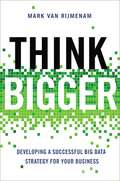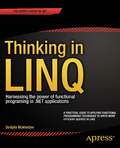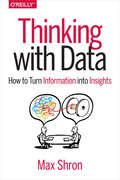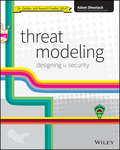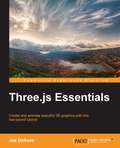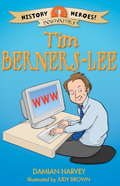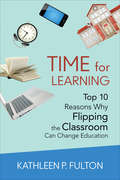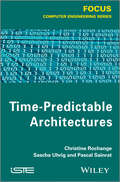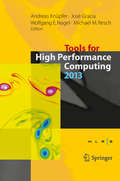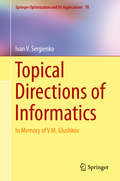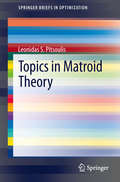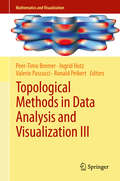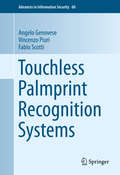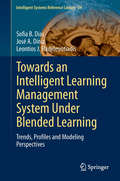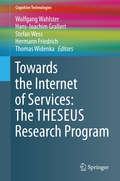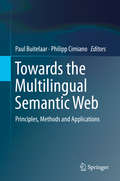- Table View
- List View
Things a Little Bird Told Me: Confessions of the Creative Mind
by Biz StoneBiz Stone, the co-founder of Twitter, discusses the power of creativity and how to harness it, through stories from his remarkable life and career. THINGS A LITTLE BIRD TOLD ME From GQ's "Nerd of the Year" to one of Time's most influential people in the world, Biz Stone represents different things to different people. But he is known to all as the creative, effervescent, funny, charmingly positive and remarkably savvy co-founder of Twitter-the social media platform that singlehandedly changed the way the world works. Now, Biz tells fascinating, pivotal, and personal stories from his early life and his careers at Google and Twitter, sharing his knowledge about the nature and importance of ingenuity today. In Biz's world: * Opportunity can be manufactured * Great work comes from abandoning a linear way of thinking * Creativity never runs out * Asking questions is free * Empathy is core to personal and global success. In this book, Biz also addresses failure, the value of vulnerability, ambition, and corporate culture. Whether seeking behind-the-scenes stories, advice, or wisdom and principles from one of the most successful businessmen of the new century, THINGS A LITTLE BIRD TOLD ME will satisfy every reader.
Things a Little Bird Told Me: Confessions of the Creative Mind
by Biz StoneBiz Stone, the co-founder of Twitter, discusses the power of creativity and how to harness it, through stories from his remarkable life and career.THINGS A LITTLE BIRD TOLD MEFrom GQ's "Nerd of the Year" to one of Time's most influential people in the world, Biz Stone represents different things to different people. But he is known to all as the creative, effervescent, funny, charmingly positive and remarkably savvy co-founder of Twitter-the social media platform that singlehandedly changed the way the world works. Now, Biz tells fascinating, pivotal, and personal stories from his early life and his careers at Google and Twitter, sharing his knowledge about the nature and importance of ingenuity today. In Biz's world:-Opportunity can be manufactured-Great work comes from abandoning a linear way of thinking-Creativity never runs out -Asking questions is free-Empathy is core to personal and global success In this book, Biz also addresses failure, the value of vulnerability, ambition, and corporate culture. Whether seeking behind-the-scenes stories, advice, or wisdom and principles from one of the most successful businessmen of the new century, THINGS A LITTLE BIRD TOLD ME will satisfy every reader.
Think Bigger: Developing a Successful Big Data Strategy for Your Business
by Mark Van RijmenamBig data--the enormous amount of data that is created as virtually every movement, transaction, and choice we make becomes digitized--is revolutionizing business. Offering real-world insight and explanations, this book provides a roadmap for organizations looking to develop a profitable big data strategy...and reveals why it's not something they can leave to the I.T. department. Sharing best practices from companies that have implemented a big data strategy including Walmart, InterContinental Hotel Group, Walt Disney, and Shell, Think Bigger covers the most important big data trends affecting organizations, as well as key technologies like Hadoop and MapReduce, and several crucial types of analyses. In addition, the book offers guidance on how to ensure security, and respect the privacy rights of consumers. It also examines in detail how big data is impacting specific industries--and where opportunities can be found. Big data is changing the way businesses--and even governments--are operated and managed. Think Bigger is an essential resource for anyone who wants to ensure that their company isn't left in the dust.
Thinking in LINQ
by Sudipta MukherjeeLINQ represents a paradigm shift for developers used to an imperative/object oriented programming style, because LINQ draws on functional programming principles. Thinking in LINQ addresses the differences between these two by providing a set of succinct recipes arranged in several groups, including: Basic and extended LINQ operators Text processing Loop refactoring Monitoring code health Reactive Extensions (Rx. NET) Building domain-specific languages Using the familiar "recipes" approach, Thinking in LINQ shows you how to approach building LINQ-based solutions, how such solutions are different from what you already know, and why they're better. The recipes cover a wide range of real-world problems, from using LINQ to replace existing loops, to writing your own Swype-like keyboard entry routines, to finding duplicate files on your hard drive. The goal of these recipes is to get you "thinking in LINQ," so you can use the techniques in your own code to write more efficient and concise data-intensive applications. What you'll learn Basic and extended LINQ operators Text processing Loop refactoring Monitoring code health Reactive Extensions (Rx. NET) Building domain-specific languages Who this book is for . NET programmers who are comfortable with some high level programming language like C++/C#. Prior knowledge of LINQ is helpful but not required. Table of Contents 1. Thinking Functionally 2. Series Generation 3. Text Processing 4. Refactoring with LINQ 5. Refactoring with MoreLINQ 6. Creating DSL using LINQ 7. Static Code Analysis 8. Exploratory Data Analysis 9. Interacting with the File System Appendix A: Lean LINQ Tips Appendix B: Taming Streaming Data with Rx. NET
Thinking with Data: How to Turn Information into Insights
by Max ShronMany analysts are too concerned with tools and techniques for cleansing, modeling, and visualizing datasets and not concerned enough with asking the right questions. In this practical guide, data strategy consultant Max Shron shows you how to put the why before the how, through an often-overlooked set of analytical skills.Thinking with Data helps you learn techniques for turning data into knowledge you can use. You’ll learn a framework for defining your project, including the data you want to collect, and how you intend to approach, organize, and analyze the results. You’ll also learn patterns of reasoning that will help you unveil the real problem that needs to be solved.Learn a framework for scoping data projectsUnderstand how to pin down the details of an idea, receive feedback, and begin prototypingUse the tools of arguments to ask good questions, build projects in stages, and communicate resultsExplore data-specific patterns of reasoning and learn how to build more useful argumentsDelve into causal reasoning and learn how it permeates data workPut everything together, using extended examples to see the method of full problem thinking in action
Threat Modeling: Designing for Security
by Adam ShostackThe only security book to be chosen as a Dr. Dobbs Jolt Award Finalist since Bruce Schneier's Secrets and Lies and Applied Cryptography!Adam Shostack is responsible for security development lifecycle threat modeling at Microsoft and is one of a handful of threat modeling experts in the world. Now, he is sharing his considerable expertise into this unique book. With pages of specific actionable advice, he details how to build better security into the design of systems, software, or services from the outset. You'll explore various threat modeling approaches, find out how to test your designs against threats, and learn effective ways to address threats that have been validated at Microsoft and other top companies. Systems security managers, you'll find tools and a framework for structured thinking about what can go wrong. Software developers, you'll appreciate the jargon-free and accessible introduction to this essential skill. Security professionals, you'll learn to discern changing threats and discover the easiest ways to adopt a structured approach to threat modeling. Provides a unique how-to for security and software developers who need to design secure products and systems and test their designs Explains how to threat model and explores various threat modeling approaches, such as asset-centric, attacker-centric and software-centric Provides effective approaches and techniques that have been proven at Microsoft and elsewhere Offers actionable how-to advice not tied to any specific software, operating system, or programming language Authored by a Microsoft professional who is one of the most prominent threat modeling experts in the world As more software is delivered on the Internet or operates on Internet-connected devices, the design of secure software is absolutely critical. Make sure you're ready with Threat Modeling: Designing for Security.
Three.js Essentials
by Jos DirksenThis book is an easy-to-follow guide that shows the essential parts of Three.js through a set of extensive examples. Through the explanation of these examples, you'll learn everything you need to know about Three.js. If you already know JavaScript and want to quickly learn the essentials of Three.js, this book is for you. No prior knowledge of Three.js, WebGL, 3D modelling, or Maths is required.
Tim Berners-Lee (History Heroes #6)
by Damian HarveyTim Berners Lee started off his career building computers out of old televisions. He is now one of the most prolific internet experts in the world and was responsible for founding the World Wide Web!Discover the stories of people who have helped to shape history, ranging from early explorers such as Christopher Columbus to more modern figures like Tim Berners-Lee, inventor of the World Wide Web.These chapter books combine historical fact with engaging narrative and humourous illustration, perfect for the newly independent reader.
Time for Learning: Top 10 Reasons Why Flipping the Classroom Can Change Education
by Kathleen P. FultonThe guide school leaders need to reap the rewards of education’s most exciting new trend. Flipping classrooms—using class time for hands-on learning and "off loading" the lecture portion of lessons to teacher-created videos or other technology presentations assigned as homework—is taking schools by storm. But like all hot trends, it is important to apply this innovation intelligently, especially at the system-wide level. This book makes a persuasive case to leaders for the potential benefits of flipping. Backed by powerful data and compelling anecdotes, this book covers: Data on positive student outcomes in terms of achievement and motivation How flipping gives teachers more time to work with students one-on-one and encourage peer learning Ways flipping can benefit teacher learning and collaboration Why flipping encourages students to take responsibility for their own learning How flipping engages students in 21st century skills Ways flipping is budget and resource-friendly With this book, you can take a major step towards the future of education, utilizing technology and advanced understanding of how students learn best. "Flipped classrooms empower teachers to engage students in deeper learning. This book gives readers ten reasons for joining forces to make this possibility a reality." —Tom Carroll, President National Commission on Teaching and America’s Future "I highly recommend this book for any educator interested in flipping the classroom to reinvent the learning process. The stories show how flipping is energizing teachers and students—with powerful results!" —Lisa Schmucki, Founder and CEO edweb.net
Time for Learning: Top 10 Reasons Why Flipping the Classroom Can Change Education
by Kathleen P. FultonThe guide school leaders need to reap the rewards of education’s most exciting new trend. Flipping classrooms—using class time for hands-on learning and "off loading" the lecture portion of lessons to teacher-created videos or other technology presentations assigned as homework—is taking schools by storm. But like all hot trends, it is important to apply this innovation intelligently, especially at the system-wide level. This book makes a persuasive case to leaders for the potential benefits of flipping. Backed by powerful data and compelling anecdotes, this book covers: Data on positive student outcomes in terms of achievement and motivation How flipping gives teachers more time to work with students one-on-one and encourage peer learning Ways flipping can benefit teacher learning and collaboration Why flipping encourages students to take responsibility for their own learning How flipping engages students in 21st century skills Ways flipping is budget and resource-friendly With this book, you can take a major step towards the future of education, utilizing technology and advanced understanding of how students learn best. "Flipped classrooms empower teachers to engage students in deeper learning. This book gives readers ten reasons for joining forces to make this possibility a reality." —Tom Carroll, President National Commission on Teaching and America’s Future "I highly recommend this book for any educator interested in flipping the classroom to reinvent the learning process. The stories show how flipping is energizing teachers and students—with powerful results!" —Lisa Schmucki, Founder and CEO edweb.net
Time-Predictable Architectures
by Sascha Uhrig Pascal Sainrat Christine RochangeBuilding computers that can be used to design embedded real-time systems is the subject of this title. Real-time embedded software requires increasingly higher performances. The authors therefore consider processors that implement advanced mechanisms such as pipelining, out-of-order execution, branch prediction, cache memories, multi-threading, multicorearchitectures, etc. The authors of this book investigate the timepredictability of such schemes.
Tizen Cookbook
by Leon AnaviIf you want to enter the fascinating world of Tizen and learn how to develop engaging and successful applications then this book is for you. It'll benefit novices and experienced application developers alike.
Tools for High Performance Computing 2013
by Andreas Knüpfer José Gracia Wolfgang E. Nagel Michael M. ReschCurrent advances in High Performance Computing (HPC) increasingly impact efficient software development workflows. Programmers for HPC applications need to consider trends such as increased core counts, multiple levels of parallelism, reduced memory per core, and I/O system challenges in order to derive well performing and highly scalable codes. At the same time, the increasing complexity adds further sources of program defects. While novel programming paradigms and advanced system libraries provide solutions for some of these challenges, appropriate supporting tools are indispensable. Such tools aid application developers in debugging, performance analysis, or code optimization and therefore make a major contribution to the development of robust and efficient parallel software. This book introduces a selection of the tools presented and discussed at the 7th International Parallel Tools Workshop, held in Dresden, Germany, September 3-4, 2013.
Top Tips for Life
by David HarrisLife doesn’t come with an instruction manual. But if it did, and if that manual was cobbled together in five minutes by a drunken idiot-genius, then it might look something like these crowd-sourced tips and ill-thought-out ideas. Covering everything from how best to turn your cat into a fearsome stegosaurus to pre-empting jellyfish stings, this book presents the wealth of knowledge gleaned from the dusty vaults of twitter’s hugely popular @TwopTwips. From the profane to the ridiculous, these laugh-at-loud nuggets of advice, with absurd and informative illustrations, will change your life in a hugely insignificant way.Tips include:BORED of a friend's text messages? Reply with 'unsubscribe' and they'll get the hint.SPICE up a boring salad by replacing the vegetables with bacon and placing between two slices of bread.STOP your dog from pulling on its lead by walking a bit faster.PREPARE your children for office life by acting awkwardly around them in the kitchen.AVOID the hassle and expense of hair straighteners by not eating your crusts.
Topical Directions of Informatics
by Ivan V. SergienkoThis work is devoted to the late Ukrainian computer scientist V. M. Glushkov on the 90th anniversary of his birthday. Dr. Glushkov is known for his contribution to the world computer science and technology and this volume analyzes the ideas and paths of development of informatics formulated by him and demonstrate their important role in constructing computer technologies of basic research in the fields of applied mathematics, theories of computer programming and computing systems. A significant portion of the monograph is devoted to the elucidation of new results obtained in the field of mathematical modeling of complicated processes, creation of new methods for solving and investigating optimization problems in different statements and development of computer technologies for investigations in the field of economy, biology, medicine and information security in systems. The monograph will be of particular interest to informatics specialists and experts using methods of informatics and computer technologies to investigate complicated processes of different natures and developing new information technologies. It may also be useful for both graduate students and postgraduates specializing in Computer Science.
Topics in Matroid Theory
by Leonidas S. PitsoulisTopics in Matroid Theory provides a brief introduction to matroid theory with an emphasis on algorithmic consequences. Matroid theory is at the heart of combinatorial optimization and has attracted various pioneers such as Edmonds, Tutte, Cunningham and Lawler among others. Matroid theory encompasses matrices, graphs and other combinatorial entities under a common, solid algebraic framework, thereby providing the analytical tools to solve related difficult algorithmic problems. The monograph contains a rigorous axiomatic definition of matroids along with other necessary concepts such as duality, minors, connectivity and representability as demonstrated in matrices, graphs and transversals. The author also presents a deep decomposition result in matroid theory that provides a structural characterization of graphic matroids, and show how this can be extended to signed-graphic matroids, as well as the immediate algorithmic consequences.
Topics in Quaternion Linear Algebra (Princeton Series in Applied Mathematics #45)
by Leiba RodmanQuaternions are a number system that has become increasingly useful for representing the rotations of objects in three-dimensional space and has important applications in theoretical and applied mathematics, physics, computer science, and engineering. This is the first book to provide a systematic, accessible, and self-contained exposition of quaternion linear algebra. It features previously unpublished research results with complete proofs and many open problems at various levels, as well as more than 200 exercises to facilitate use by students and instructors. Applications presented in the book include numerical ranges, invariant semidefinite subspaces, differential equations with symmetries, and matrix equations.Designed for researchers and students across a variety of disciplines, the book can be read by anyone with a background in linear algebra, rudimentary complex analysis, and some multivariable calculus. Instructors will find it useful as a complementary text for undergraduate linear algebra courses or as a basis for a graduate course in linear algebra. The open problems can serve as research projects for undergraduates, topics for graduate students, or problems to be tackled by professional research mathematicians. The book is also an invaluable reference tool for researchers in fields where techniques based on quaternion analysis are used.
Topological Methods in Data Analysis and Visualization III
by Peer-Timo Bremer Ingrid Hotz Valerio Pascucci Ronald PeikertThis collection of peer-reviewed conference papers provides comprehensive coverage of cutting-edge research in topological approaches to data analysis and visualization. It encompasses the full range of new algorithms and insights, including fast homology computation, comparative analysis of simplification techniques, and key applications in materials and medical science. The volume also features material on core research challenges such as the representation of large and complex datasets and integrating numerical methods with robust combinatorial algorithms. Reflecting the focus of the TopoInVis 2013 conference, the contributions evince the progress currently being made on finding experimental solutions to open problems in the sector. They provide an inclusive snapshot of state-of-the-art research that enables researchers to keep abreast of the latest developments and provides a foundation for future progress. With papers by some of the world's leading experts in topological techniques, this volume is a major contribution to the literature in a field of growing importance with applications in disciplines that range from engineering to medicine.
Touchless Palmprint Recognition Systems
by Vincenzo Piuri Angelo Genovese Fabio ScottiThis book examines the context, motivation and current status of biometric systems based on the palmprint, with a specific focus on touchless and less-constrained systems. It covers new technologies in this rapidly evolving field and is one of the first comprehensive books on palmprint recognition systems. It discusses the research literature and the most relevant industrial applications of palmprint biometrics, including the low-cost solutions based on webcams. The steps of biometric recognition are described in detail, including acquisition setups, algorithms, and evaluation procedures. Constraints and limitations of current palmprint recognition systems are analyzed and discussed. The authors also introduce innovative methods for touchless and less-constrained palmprint recognition, with the aim to make palmprint biometrics easier to use in practical, daily-life applications, and overcome the typical constraints and limitations described. Touchless Palmprint Recognition Systems targets professionals and researchers working in biometrics, image processing and three-dimensional reconstruction. Advanced-level students studying biometrics and computer science will also find this material valuable as a secondary text book or reference.
Towards a Theoretical Neuroscience: from Cell Chemistry to Cognition
by L. Andrew CowardThe book explains how to understand cognition in terms of brain anatomy, physiology and chemistry, using an approach adapted from techniques for understanding complex electronic systems. These techniques create hierarchies of information process based descriptions on different levels of detail, where higher levels contain less information and can therefore describe complete cognitive phenomena, but are more approximate. The nature of the approximations are well understood, and more approximate higher level descriptions can therefore be mapped to more precise detailed descriptions of any part of a phenomenon as required. Cognitive phenomena, the anatomy and connectivity of major brain structures, neuron physiology, and cellular chemistry are reviewed. Various cognitive tasks are described in terms of information processes performed by different major anatomical structures. These higher level descriptions are selectively mapped to more detailed physiological and chemical levels.
Towards an Intelligent Learning Management System Under Blended Learning
by Sofia B. Dias José A. Diniz Leontios J. HadjileontiadisWhat are the key channels to change in blended instructional practice as they relate to the use of a learning management system (LMS)? What role LMS users' profiles play in facilitating change in practice? Can we model users' quality of interaction (QoI) with LMS? How inclusiveness and affectiveness could lead to a personalized intelligent LMS (iLMS)? If these questions sound intrinsic to you and to your own experience and circumstance, then this book fits absolutely to you. Here, the term Blended - viewed as a fuzzy concept - is understood as a stepping-stone on the way to the future, to explain the multiple ways human beings think/act/feel of society in the 21st century and to embrace the opportunity of humans to re/co-construct new knowledge through the intermediation role of the technology. Initially, based on an online learning environment' theoretical framework, some current issues of the educational processes in the digital age of Web 2. 0 are analyzed. Then, after exploring the main methodological procedures, characteristic examples of research case studies follow, including LMS users' trends and profiles and modeling of their QoI using fuzzy logic. This book offers useful information that evokes initiatives towards rethinking of the value, efficiency, inclusiveness, affectiveness and personalization of the iLMS-based b-learning environment, both by the educators, the LMS designers and educational policy decision makers.
Towards the Internet of Services: The THESEUS Research Program
by Wolfgang Wahlster Hans-Joachim Grallert Stefan Wess Hermann Friedrich Thomas WidenkaThe Internet of Services and the Internet of Things are major building blocks of the Future Internet. The digital enterprise of the future is based not only on mobile, social, and cloud technologies, but also on semantic technologies and the future Internet of Everything. Semantic technologies now enable mass customization for the delivery of goods and services that meet individual customer needs and tastes with near mass production efficiency and reliability. This is creating a competitive advantage in the industrial economy, the service economy, and the emerging data economy, leading to smart products, smart services, and smart data, all adaptable to specific tasks, locations, situations, and contexts of smart spaces. Such technologies allow us to describe, revise, and adapt the characteristics, functions, processes, and usage patterns of customization targets on the basis of machine-understandable content representation that enables automated processing and information sharing between human and software agents. This book explains the principal achievements of the Theseus research program, one of the central programs in the German government's Digital 2015 initiative and its High-Tech Strategy 2020. The methods, toolsets, and standards for semantic technologies developed during this program form a solid basis for the fourth industrial revolution (Industrie 4. 0), the hybrid service economy, and the transformation of big data into useful smart data for the emerging data economy. The contributing authors are leading scientists and engineers, representing world-class academic and industrial research teams, and the ideas, technologies, and representative use cases they describe in the book derive from results in multidisciplinary fields, such as the Internet of Services; the Semantic Web, and semantic technologies, knowledge management, and search; user interfaces, multimodal interaction, and visualization; machine learning and data mining; and business process support, manufacturing, automation, medical systems, and integrated service engineering. The book will be of value to both researchers and practitioners in these domains.
Towards the Multilingual Semantic Web
by Paul Buitelaar Philipp CimianoTo date, the relation between multilingualism and the Semantic Web has not yet received enough attention in the research community. One major challenge for the Semantic Web community is to develop architectures, frameworks and systems that can help in overcoming national and language barriers, facilitating equal access to information produced in different cultures and languages. As such, this volume aims at documenting the state-of-the-art with regard to the vision of a Multilingual Semantic Web, in which semantic information will be accessible in and across multiple languages. The Multilingual Semantic Web as envisioned in this volume will support the following functionalities: (1) responding to information needs in any language with regard to semantically structured data available on the Semantic Web and Linked Open Data (LOD) cloud, (2) verbalizing and accessing semantically structured data, ontologies or other conceptualizations in multiple languages, (3) harmonizing, integrating, aggregating, comparing and repurposing semantically structured data across languages and (4) aligning and reconciling ontologies or other conceptualizations across languages. The volume is divided into three main sections: Principles, Methods and Applications. The section on "Principles" discusses models, architectures and methodologies that enrich the current Semantic Web architecture with features necessary to handle multiple languages. The section on "Methods" describes algorithms and approaches for solving key issues related to the construction of the Multilingual Semantic Web. The section on "Applications" describes the use of Multilingual Semantic Web based approaches in the context of several application domains. This volume is essential reading for all academic and industrial researchers who want to embark on this new research field at the intersection of various research topics, including the Semantic Web, Linked Data, natural language processing, computational linguistics, terminology and information retrieval. It will also be of great interest to practitioners who are interested in re-examining their existing infrastructure and methodologies for handling multiple languages in Web applications or information retrieval systems.
Tractability
by Lucas Bordeaux Youssef Hamadi Pushmeet KohliClassical computer science textbooks tell us that some problems are 'hard'. Yet many areas, from machine learning and computer vision, to theorem proving and software verification, have defined their own set of tools for effectively solving complex problems. Tractability provides an overview of these different techniques, and of the fundamental concepts and properties used to tame intractability. This book will help you understand what to do when facing a hard computational problem. Can the problem be modelled by convex, or submodular functions? Will the instances arising in practice be of low treewidth, or exhibit another specific graph structure that makes them easy? Is it acceptable to use scalable, but approximate algorithms? A wide range of approaches is presented through self-contained chapters written by authoritative researchers on each topic. As a reference on a core problem in computer science, this book will appeal to theoreticians and practitioners alike.
Trade Secret Theft, Industrial Espionage, and the China Threat
by Carl RoperThis book provides an overview of economic espionage as practiced by a range of nations from around the world focusing on the mass scale in which information is being taken for China's growth and development. It supplies an understanding of how the economy of a nation can prosper or suffer, depending on whether that nation is protecting its intellectual property, or whether it is stealing such property for its own use. The text concludes by outlining specific measures that corporations and their employees can practice to protect information and assets, both at home and abroad.


